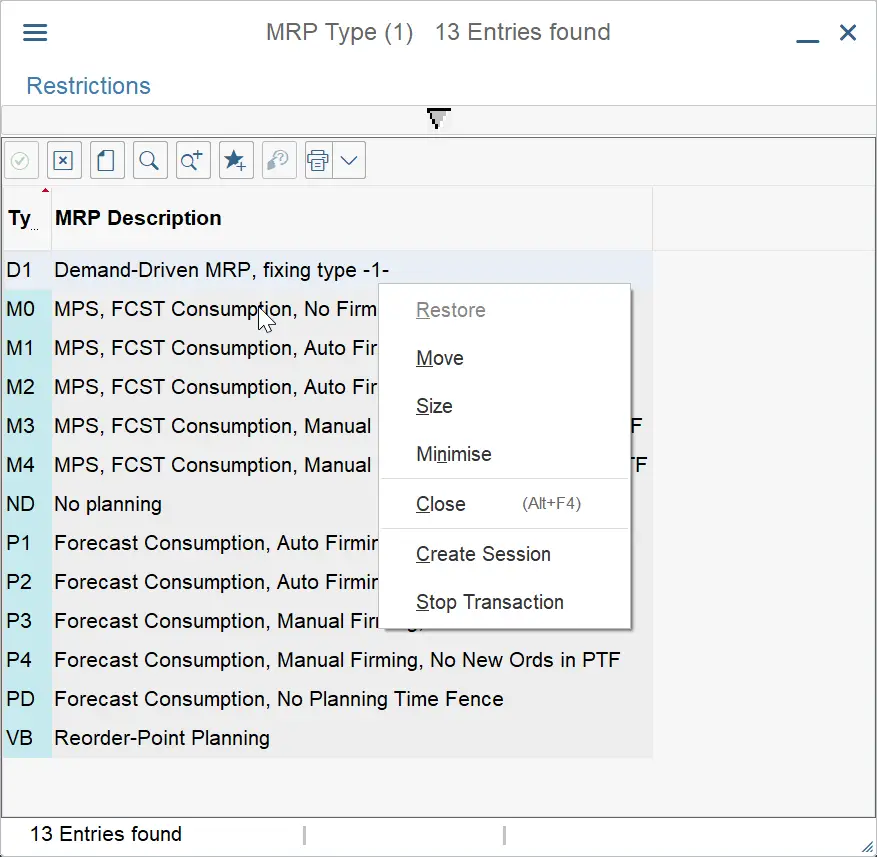SAP MM interview questions – and their answers
SAP MM interview questions and answers
See below a list of probable common SAP interview questions and their answers. Do not hesitate to look up in an actual working SAP system how these answers are really put at use before going on an interview.
1 – MRP Procedures available in consumption Based Planning
There are several planning methods used in the MRP, the Materials Requirements Planning:
– Reorder point procedure (VM),
– Forecast-based planning (VV),
– Time-Phased materials planning (PD).
They are actually detailed in the material creation transaction MM01, in the MRP1 tab.
2 – How are planned orders created
Planned orders are created after an internal procurement proposal, created by the system.
The MRP controller might create a planned order during a vendor procurement, or directly create a purchase requisition.
After a planned has been converted to a purchase requisition, it will go to the purchasing department, where it might be followed up by a purchase order.
Planned orders can be converted to purchase requisitions with the transaction code MD14.

3 – What are the enterprise structure organization levels
SAP organization level starts on client level, after which comes the company code, a unit that has its own accounting, financial balance, profit and loss.
After that level, a company can have several plants, the operational units of a company. It can represent a headquarter, a plant, a sales office, or any other company internal organization.
A purchasing organization, divided in purchasing groups, will be the following organizational unit of an enterprise structure.
4 – How to organize purchasing organizations
A purchasing organization might belong to a company, and not to a plant, and generally manages the purchases for several plants at once, which would be called the centralized purchasing.
It is also possible to have one purchasing organization per plant, in which case it would be called a centralized purchasing.
5 – Define Special Stocks
A special stock is registered in accounting, but is not owned or stored by the company.
For example, consignment is a special stock.
6 – How to transfer materials to another plant
It is possible to transfer materials without a stock transport order, but it shouldn’t be done, as documents such as goods receipt, purchase order history, or stock transport order would be lost.
7 – Difference between purchase order and purchase requisition
A purchase requisition is an internal only document that notifies the purchasing department of the request to procure a material.
A purchase order is a binding document sent to an external supplier to deliver some goods in exchange of a payment.
8 – What is an RFQ
An RFQ is a Request For Quotation. That document is sent to several suppliers that might be able to fulfill a purchase requisition.
SAP system is then able to select the best supplier based on their answers.
9 – What Is Release Procedure
The release procedure approves some documents, for example purchase requisitions or purchase orders, based on defined configured criteria.
When different departments are responsible for different material groups, the release procedure will define different actions.
10 – How to do a goods issue
With the transaction MIGO it is possible to perform goods issue.
The movement type is an important information for the goods issue.
It can be created directly from an existing order, or all items can be created manually.

11 – How to return items to a vendor
After having posted goods receipt for a given purchase order, it is possible to define some items as marked for return to vendor.
The movement type for a return to vendor is 161.
12 – What are the master data key components
The key components of the Material Master master data are the following:
– Material info records, accessible in transaction ME11,
– Source lists, accessible in transaction ME01,
– Quota arrangements, accessible in transaction MEQ1,
– Vendors, accessible in transaction MK01,
– Vendor evaluation, accessible in transaction ME61,
– Condition type, accessible in transaction MEKA.

13 – What is vendor evaluation
The vendor evaluation transaction ME61 is used to select the right source of supply, using scores by particular vendor.
Scores are from 1 to 100, and depend on many criteria.

14 – What is the Material Master data table
The main tables of the material master data are MARA, general data, and MARC, plant data.
Many other tables are used, but are secondary, such as MBEW, MARD, and more.

15 – How to find the logical value for stock item
This information can be found in the transaction MC49, key figure: average value stock.

16- How to perform an invoice verification
When an invoice refers to an existing document, such as a purchase order, the system will get all data related to the invoice from the purchase order, such as vendor, material, quantity, and all item lines and details from the purchase order.
This invoice posting is done in transaction MIRO.


